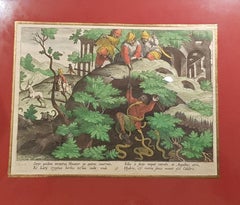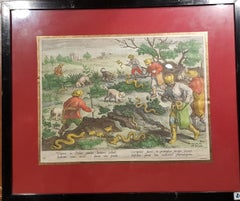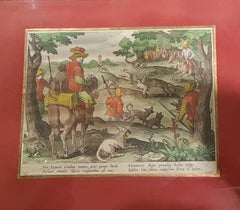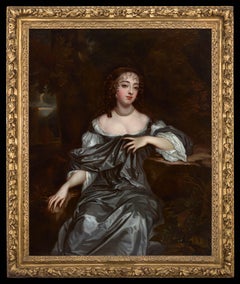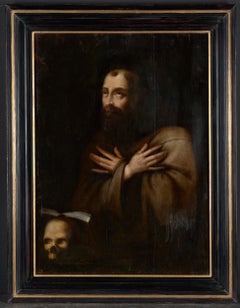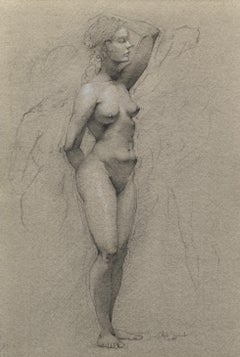Renaissance More Art
to
1
7
5
6
5
8
1
1
2
Overall Height
to
Overall Width
to
3,233
2,643
2,555
1,495
658
292
207
207
173
48
47
45
43
33
3
3
2
2
2
1
5
1
6
4
5
4
4
4
4
Style: Renaissance
Eli
Located in Mokena, IL
Eli, 11.5 x 13.5 inches. Oil on panel with carved and gilded frame. Painting by artist Justas Varpucanskis. 21st century contemporary artwork that employs techniques, philosophy and ...
Category
21st Century and Contemporary Renaissance More Art
Materials
Gold Leaf
Ritratto con paesaggio
Located in Mokena, IL
Ritratto con paesaggio, 14 x 12 inches. Oil on panel with frame. Painting by artist Justas Varpucanskis. 21st century contemporary artwork that employs techniques, philosophy and vis...
Category
21st Century and Contemporary Renaissance More Art
Materials
Oil
La Bella Attrice
Located in Mokena, IL
La Bella Attrice, 7.75 x 5.5 inches. Graphite and White Chalk on Toned Paper. Drawing by artist Justas Varpucanskis. This piece utilizes the "rules of craftsmanship" as outlined in C...
Category
21st Century and Contemporary Renaissance More Art
Materials
Chalk, Graphite
Hunting Engraving: Hunting Ibex With Snakes
Located in Paris, FR
Engraving: The Ibex hunting with snakes
Historical , mythological, religious, allegorical subjects, genre scenes, landscape painter.
Mannerist. He settled in Antwerp, Venice, Flore...
Category
18th Century Renaissance More Art
Materials
Engraving
Engraving Hunting: The Hunt For The Vipers
Located in Paris, FR
Engraving, "the hunt for vipers" xylographs (wood and copper engravings), after Jan Van der Straeten, dit Stradanus (Bruges 1523-Florence 1605). Painter of history, mythological, rel...
Category
18th Century Renaissance More Art
Materials
Engraving
Engraving Hunting: Hares Hunting With Cheetah
Located in Paris, FR
Engraving, "The hare hunt with Cheetah" xylographs (woodcuts and copper engravings), after Jan Van der Straeten, dit Stradanus (Bruges 1523-Florence 1605). Painter of history, mythol...
Category
18th Century Renaissance More Art
Materials
Engraving
Engraving Hunting: Deer Hunting With Lasso
Located in Paris, FR
Engraving: The Deer hunting
Woodcuts and copper engraving, after Jan Van der Straeten so called Stradanus (Bruges 1523-Florence 1605).
A historical, mythological, religious, allegorical, genre scenes, landscape and mural compositions painter.
He lived in Antwerp, Venice, Florence, where he worked for the Medici
He then met Vasari and worked with him at the the Vatican, the Palazzo Vechio ....
Out of a set of 5 prints:
- The Duck Hunting
- The ibex hunting with dogs...
Category
18th Century Renaissance More Art
Materials
Engraving
Coronation of Venus
Located in Mokena, IL
The Coronation of Venus draws the viewer into a mystical forest where Venus, the goddess of love, is crowned by four angels. The angel of trust, on the left, gazes deeply into the eyes of Venus. Perseverance crowns her from above. Kindness is at her shoulder, and patience rests on her lap eager for guidance. As Venus looks into the distance, there is both joy and melancholy in her mysterious lips.
Technical:
114” x 78”. Oil on panel with 24k gold water-gilded frame. Painting and frame produced by artists Justas and Vilius Varpucanskis. This piece utilizes the "rules of craftsmanship" as outlined in Cenino Cennini's l Libro dell'Arte. 21st century contemporary artwork that employs techniques, philosophy, and visual language of the Italian High Renaissance...
Category
21st Century and Contemporary Renaissance More Art
Materials
Gold Leaf
School of Stoics
Located in Mokena, IL
The School of Stoics brings the viewer into an airy evening discussion at an agora overlooking the Aegean Sea. Amidst the silent water and grained marble, a group of stoics debate logic, reason, and nature. Agreement and disagreement prevail in the noble gestures of their bodies. Soon you see an individual's gaze directed towards you, raising their hand, calling you to join the conversation.
Technical:
53” x 39”. Tempera on panel with 24k gold water-gilded frame. Painting and frame produced by artists Justas and Vilius Varpucanskis. This piece utilizes the "rules of craftsmanship" as outlined in Cenino Cennini's Il Libro dell'Arte. 21st century contemporary artwork that employs techniques, philosophy, and visual language of the Italian High Renaissance...
Category
21st Century and Contemporary Renaissance More Art
Materials
Gold Leaf
Our Lady of Mercy
Located in Mokena, IL
Our Lady of Mercy, 8x14 inches. Oil on panel with water-gilded frame. Painting by artist Justas Varpucanskis. This piece utilizes the "rules of cra...
Category
21st Century and Contemporary Renaissance More Art
Materials
Gold Leaf
Florentine artisan Renaissance Baby Toilet Chair 1550s walnut wood
Located in Florence, IT
This rare object is a child toilet chair that was very common during the Renaissance time in every aristocratic house. The noble origin is also highlighted by the decoration with th...
Category
16th Century Renaissance More Art
Materials
Walnut
19th Century Pair of Hand-Carved Hall Chairs from Mexico
Located in Troy, NY
These 19th Century hand-carved hall chairs from Mexico are reminiscent of a Renaissance style in the design of the faces of the angels and ornamentation. This native wood is walnut colored with a stain that gives the chairs a caramel glow. The cushions are upholstered in a, light yellow silk brocade fabric. There are pin-sized holes from an earlier exposure to termites, a desirable element in antique Mexican furniture...
Category
19th Century Renaissance More Art
Materials
Fabric, Wood, Mixed Media
Related Items
Portrait of Frances Lady Whitmore nee Brooke, Exquisite Carved Frame, Old Master
Located in London, GB
Portrait of Frances, Lady Whitmore nee Brooke (c.1638-1690)
Circle of Sir Peter Lely (1618-1680)
Titan Fine Art presents this exquisite portrait that depicts Frances Brooke, Lady Wh...
Category
17th Century Renaissance More Art
Materials
Canvas, Oil
H 59.06 in W 49.22 in D 2.37 in
17th C, Baroque, Flemish School, Saint Francis in Ecstasy.Oil on oak panel.
Located in brussel, BE
During the Counter-Reformation, the traditional cult of saints was encouraged, and spiritual exercises were recommended to come closer to God. In the pai...
Category
17th Century Renaissance More Art
Materials
Oil
H 37.8 in W 49.02 in D 2.37 in
Portrait Gentleman Black Coat Orange Sash, Dutch Old Master, Oil on Panel c.1650
By Bartholomeus van der Helst
Located in London, GB
This exquisite portrait of a gentleman depicted in a sumptuous black coat edged with silver and slashed sleeves is an excellent example of the type of portrait fashionable in England and the Low Countries during the 17th century. The confident pose, striking orange sash - the colour of the house of Orange Nassau - and the leather gorget imbue the sitter with a sense of masculinity and power. The profusely decorated costume is of the highest quality and de rigueur of an elite class - the artist has carefully cultivated this portrait to emphasise the sitter’s wealth and standing in the society that he belonged to. The casual pose, with one arm resting on a hip, is much less formal than earlier decades, and it speaks of ‘sprezzatura’ – one’s appearance should not appear laborious, but instead, effortless.
The oil on cradled panel portrait can be dated to circa 1650 based on the hairstyle and the attire - small falling collar, short doublet (doublets reduced in size to just below the ribcage in the late 1650’s), and the type of slashed sleeves with the sleeve seams left open to reveal the white fabric.
The demand for portraits in the Netherlands was great in the 17th century. Bartholemeus van der Helst was considered to be one of the leading portrait painters of the Dutch Golden Age surpassing even Rembrandt as the most sought-after portraitist in Harlaam. The Dutch Golden Age, roughly spanning the 17th century, was a period when Dutch trade, science, military, and art were among the most acclaimed in the world. Dutch explorers charted new territory and settled abroad. Trade by the Dutch East-India Company thrived, and war heroes from the naval battles were decorated and became national heroes. During this time, The Dutch Old Masters began to prevail in the art world, creating a depth of realistic portraits of people and life in the area that has hardly been surpassed. The Golden Age painters depicted the scenes that their discerning new middle-class patrons wanted to see. This new wealth from merchant activities and exploration combined with a lack of church patronage, shifted art subjects away from biblical genres. Still life’s of items of everyday objects, landscapes, and seascapes reflecting the naval and trade power that the Republic enjoyed were popular. The new wealthy class were keen to have their portraits commissioned and many artists worked in this lucrative field. Such was the popularity of art that everyone had a painting, even the humble butcher, and hundreds of thousands of paintings were produced.
By tradition the sitter is Maarten Tromp (1598-1653) who was an Admiral in the Dutch Navy (the reverse of the portrait contains an old handwritten inscription “van Tromp”). Certainly, the distinctive orange sash is similar to those worn by officers of the Dutch army in the Netherlands who served under the Princes of Orange and the House of Nassau. However, it should be noted that the physiognomy differs from other images of Tromp.
Tromp was the oldest son of Harpert Maertensz, a naval officer and captain. He joined the Dutch navy as a lieutenant in July 1622 and was later promoted from captain to Lieutenant-Admiral of Holland and West Frisia in 1637. In 1639, during the Dutch struggle for independence from Spain, Tromp defeated a large Spanish fleet bound for Flanders at the Battle of the Downs, which marked an enormous change - the end of Spanish naval power. He was killed in action during the First Anglo-Dutch War in 1653 where he commanded the Dutch fleet in the battle of Scheveningen.
Gloves were an absolutely vital accessory and the elaborate pair in this portrait are embellished with threads of silk and precious metals and salmon-coloured lining. He wears only one glove and holds the other, providing an opportunity to better display the cuffs and detail on his right wrist and forearm. The gloves are probably made from the most prized leather which came from Spain, in particular from Cordova. Cordovan leather was tanned with a special vegetal process that left it both highly impermeable and divinely soft. King Charles I, posed in a rather relaxed manner for Daniel Mytens’s portrait in 1631, is wearing gloves and boots in matching Cordovan leather. The hide is thick, but you can see just how supple it is from the way the gauntlet dimples and the long boot legs fold over themselves, rippling and wrinkling at the ankles.
Apart from keeping hands warm the use of gloves during the 15th through the 19th centuries were full of symbolism and they were worn regardless of the season. They kept the skin unblemished - soft, smooth hands were considered highly attractive. This combination of necessity and proximity to bare skin made gloves a deeply personal gift and they took on a strong symbolic significance and were regarded as emblematic of fidelity and loyalty for hundreds of years. Such was the importance of their symbolism was that some gloves were never intended to be worn at all. Their luxury made them ideal gifts at court, and so in the 15th and 16th centuries, ambassadors often presented them as symbols of loyalty.
Until the mid-19th century, it was customary to give gloves as tokens to guests at weddings and to mourners at funerals. Gentleman often gifted their bride-to-be with a pair of gloves (the obligatory gift) and were handed over at the betrothal and put on display before the wedding took place. It was probably their direct contact with the skin that led to the eroticism of gloves. Not only were pairs often exchanged between lovers, but from the 16th to the 18th centuries, it was common practice to remove one glove and give it as a gift to a favourite. The idea of the item being presented still warm from the wearer’s hand is certainly suggestive. Following the death of King George IV, his executors purportedly found over a thousand mismatched ladies’ gloves among his possessions.
The sentiment of a 17th-century poem reveals the popularity of the practice: “Come to our wedding to requite your loves / Shew us your hands and we’ll fit you with gloves.” Such generosity might be pricey for the hosts, but gloves of varying quality could be offered depending on the status of the recipient. Pairs made with the finest Spanish leather might be reserved for immediate family, while coarse sheep’s leather could be distributed among the servants and tradesmen. The apportioning of quality according to class provided a very clear message of the gloves’ intended use. For refined guests, they were decoration; for the lower classes, they were functional.
Bartholomeus van der Helst...
Category
17th Century Renaissance More Art
Materials
Oil, Wood Panel
H 38.59 in W 31.89 in D 2.76 in
Portrait of a Lady in Silver Silk Dress & Pearls c.1660, Oil on canvas painting
Located in London, GB
This exquisite work is an accomplished example of the type of portrait in vogue in England during the third quarter of the 17th century. There was a large demand for paintings in England and the demand for portraits was greatest. Many artists worked in this lucrative field, even artists who initially trained in the more respected field of history painting, such as Peter Lely, turned their attention to portraiture to meet this demand. Moreover, it was not uncommon for the British, even for men, to present a gift of one’s portrait to a friend - portraits were first and foremost a memento.
Woman at court often vied with one another in displays of rich and fashionable clothing. The drapery was either painted from the customer’s own clothes or was perhaps a creation using fabrics loosely tacked together in the studio. This was a common practice of Lely and his studio props included swathes of fabric and pieces of cloth. The sitter’s sumptuous attire and gauze scarf, fastened by a large diamond brooch, is of the finest material and is representative of wealth. Pearls were an obligatory accompaniment since at least the 1630s and they are worn in abundance – in her hair, on her attire, as a necklace, and as pear-shaped earrings called unions d’excellence, reflecting the difficulty of finding perfectly matched pearls of such large size. They could range up to 20 millimetres in diameter. Her hairstyle help date the painting to the early 1660’s.
Peter Lely, the son of a Dutch...
Category
17th Century Renaissance More Art
Materials
Canvas, Oil
H 36.62 in W 30.71 in D 1.97 in
Portrait of a Lady in a Blue & Pink Silk Dress, possibly Mrs Rowe, Signed Dated
Located in London, GB
This charming picture, which has been signed and dated: H. Pickering pinxt 1752 is a type favoured by the highly successful artist Henry Pickering. Pickering’s painting life, from 1...
Category
18th Century Renaissance More Art
Materials
Oil, Canvas
Henry PickeringPortrait of a Lady in a Blue & Pink Silk Dress, possibly Mrs Rowe, Signed Dated, 1752
H 39.38 in W 34.65 in D 2.76 in
Portrait Of A Young Woman
By Adriano Goby
Located in San Francisco, CA
Adriano Goby 19th century oil portrait of a beautiful young lady, circa 1890s
Superb antique oil portrait, possibly, French. The painting is signed in the upper left corner (see pic...
Category
Late 19th Century Renaissance More Art
Materials
Oil
19th Century Pair of Hand-Carved Hall Chairs from Mexico
Located in Troy, NY
These 19th Century hand-carved hall chairs from Mexico are reminiscent of a Renaissance style in the design of the faces of the angels and ornamentation. This native wood is walnut colored with a stain that gives the chairs a caramel glow. The cushions are upholstered in a, light yellow silk brocade fabric. There are pin-sized holes from an earlier exposure to termites, a desirable element in antique Mexican furniture...
Category
19th Century Renaissance More Art
Materials
Fabric, Wood, Mixed Media
Portrait of a Young Gentleman and Pet Dog c.1680, Antique oil on Canvas Painting
Located in London, GB
The portrait genre was valued particularly highly in English society. Neither landscapes nor allegorical pictures were ever priced so highly at exhibitions and in the trade as depictions of people, from the highest aristocracy to scholars, writers, poets and statesmen. This charming portrait, presented by Titan Fine Art, of a fashionable young gentleman and his faithful pet is an excellent example of 17th century child portraiture in England. There is a remarkable beauty and sensitivity to the portrait. The face, particularly well rendered, has captured the character of this young man – both charming and at the same time mischievous.
Only the playful attention of a small dog suggests anything less than patrician dignity. Symbolism was important in portraiture and it provided a pointed and aspirational narrative that would not have been lost on contemporary viewers. For example, the presence of the dog, which was likely the boy’s pet, is at once a charming pictorial device and also a clear allusion to fidelity, trust and loyalty.
The hairstyle and the attire, notably the type of cravat with the blue ribbon, help to date this portrait to between 1670 to 1685. Until the late eighteenth century children were dressed as adults - boys were dressed like men in breeches, vests, and coats between four and seven years of age. The expensive lace is an indication to his family’s wealth.
Held in a good quality and condition antique gilded frame.
Born in Suffolk, Mary Beale, nee Cradock (1633-1699) was employed by many of the most distinguished persons of her time including nobility, landed gentry, and clergymen. Technically accomplished, her paintings are noteworthy for their honest and sympathetic portrayal. In 1651 she married Charles Beale...
Category
17th Century Renaissance More Art
Materials
Canvas, Oil
H 35.44 in W 32.29 in D 3.15 in
Portrait of Lady, Grace Saunderson, Viscountess Castleton Oil on canvas Painting
Located in London, GB
Portrait of Grace Saunderson, Viscountess Castleton (1635-1667) c.1665-67
Sir Peter Lely and Studio (1618-1680)
Titan Fine Art present this work, which formed part of a collection of family pictures and heirlooms of the Saunderson, Viscount Castleton family and their descendants, the Earls of Scarbrough, at their magnificent family seat Sandbeck Park, where the Earls still reside today almost four hundred years later. It was painted in the studio of Sir Peter Lely...
Category
17th Century Renaissance More Art
Materials
Canvas, Oil
H 35.04 in W 31.11 in D 1.97 in
Portrait of a Lady, Maria Virginia Borghese Chigi Princess Farnese Oil on canvas
Located in London, GB
This exquisite portrait, presented by Titan Fine Art, belongs to a type of portrait known as ‘Les Belle Romanes’; Voet is perhaps best remembered for his series of them – a great set of portraits...
Category
17th Century Renaissance More Art
Materials
Canvas, Oil
Portrait of Young Gentleman, Lord George Douglas, Arcadian Landscape c.1710
Located in London, GB
Portrait of Young Gentleman, Lord George Douglas, in an Arcadian Landscape c.1710
Attributed to Charles D'Agar (1669-1723)
Depicted with bow in hand and situated against an Arcadian...
Category
18th Century Renaissance More Art
Materials
Oil, Canvas
H 58.27 in W 48.82 in D 3.15 in
Portrait of a Lady, Katherine St Aubyn, Godolphin, Cornelius Johnson, Oil canvas
By Cornelius Johnson
Located in London, GB
Titan Fine Art are pleased to present this charming bust-length portrait, which is a good example of the style of portrait painted in England in the second quarter of the seventeenth century. The attire consists of the finest silks, and the full billowing sleeves, bows, and hairstyle help in dating this portrait to circa 1637. The accessory par excellence – pearls – are worn as a necklace and were a very popular accessory. The artist makes no attempt to obey the rules of Baroque and instead sensitively depicts in complete honesty his sitter against a plain wall, and without distracting backdrops and flowing draperies – this work is very redolent of the sumptuous half-length female portraits that Cornelius Johnson...
Category
17th Century Renaissance More Art
Materials
Canvas, Cotton Canvas, Oil
H 32.29 in W 27.96 in D 1.58 in
Previously Available Items
Florentine Figure Drawing
Located in Mokena, IL
Florentine Figure Drawing, 7x10 inches. Graphite and White Chalk on Toned Paper. Drawing by artist Justas Varpucanskis. This piece utilizes the "ru...
Category
21st Century and Contemporary Renaissance More Art
Materials
Chalk, Handmade Paper, Graphite
Renaissance Engraving, Dogs, Virgil Solis, 16th Century, Old Master, Paper Art
By Virgil Solis
Located in Greven, DE
Engraving by the artist Virgil Solis, Six dogs; standing, reclining and seated among trees.
Engraving, made by Virgil Solis.
German, c. 1530-1562.
Si...
Category
16th Century Renaissance More Art
Materials
Paper, Engraving
Ulisse Cantagalli Bottle Lustre Florence Phoenix Lapis Lazuli Blue Silver
Located in Eversholt, Bedfordshire
Ulisse Cantagalli (1839-1901) Florence, exceptional, lustre bottle, circa 1880
- Outstanding, recreation of the complex and subtle 16th century, orn...
Category
1880s Renaissance More Art
Materials
Glass, Luster
Engraving Hunting: Duck Hunting with Falcon
Located in Paris, FR
Engraving, "duck hunting with hawks" xylographs (woodcuts and copper engravings), after Jan Van der Straeten, so called Stradanus (Bruges 1523-Florence 16...
Category
18th Century Renaissance More Art
Materials
Engraving
For Soul and Body
Located in New Orleans, LA
Magnificent and colorful, this enchanting Florentine work of art is not a painting, but upon closer inspection is revealed to be a superb example of the intensive art of pietre dure...
Category
Late 19th Century Renaissance More Art
Materials
Stone, Marble
Cup with Saucer Set “Red”
Located in Kansas City, MO
Cup with Saucer Set “Red”
Materials Used: Porcelain, Glaze, China Paint, Gold Luster, Decals
Year: 2018
Height: 5″
Width: 5″
Depth: 3.75″
One-of-a-kind ceramics work, completely handmade and handpainted, by Melanie Sherman. I make all of my pieces in small batches to ensure quality and uniqueness. Not one is ever like the other. This is a set of cup and saucer...
Category
2010s Renaissance More Art
Materials
Gold
Renaissance more art for sale on 1stDibs.
Find a wide variety of authentic Renaissance more art available for sale on 1stDibs. Works in this style were very popular during the 21st Century and Contemporary, but contemporary artists have continued to produce works inspired by this movement. Frequently made by artists working with Wood, and Paint and other materials, all of these pieces for sale are unique and have attracted attention over the years. Not every interior allows for large Renaissance more art, so small editions measuring 5.5 inches across are also available. Prices for more art made by famous or emerging artists can differ depending on medium, time period and other attributes. On 1stDibs, the price for these items starts at $327 and tops out at $475,000, while the average work sells for $8,024.
Recently Viewed
View AllMore Ways To Browse
South Africa Green Painting
Mexican Fiber Art
Original Vintage 1940s Dress Dresses
Original Vintage 1940s Dress
John Louis Interiors
Little Albert
Mother Mary With Child
Vintage 8 Doll
Vintage Childrens Book Illustrators
1965 Vintage Watch
James Craig
Japanese Ink Bird
Old Masters Biblical
Original Vintage Travel Posters Italy
Philip Thomas
Warhol Brillo
1920 Program
19th Century Portraits Couple



